Zscaler Bundle
How Did Zscaler Revolutionize Internet Security?
In a world increasingly reliant on the cloud, Zscaler emerged as a visionary, fundamentally changing how businesses approach cybersecurity. Founded in 2007, this cybersecurity company saw the future of work and data security before many others. Their innovative approach shifted the focus from outdated, hardware-based security to a dynamic, cloud-delivered model.
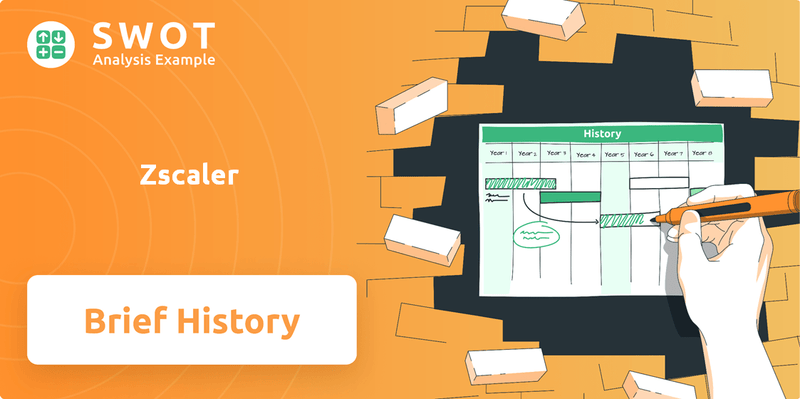
Zscaler's journey began with a bold vision: to secure the cloud and mobile-first environments. This foresight allowed Zscaler to become a leader in the Secure Access Service Edge (SASE) market. For an in-depth look at their strategic positioning, consider the Zscaler SWOT Analysis. Today, Zscaler's $27 billion market cap reflects its significant impact on the cybersecurity landscape, making it a company to watch.
What is the Zscaler Founding Story?
The story of Zscaler began on September 22, 2007. The company was founded by Jay Chaudhry, who currently serves as its Chairman and CEO. Chaudhry, a serial entrepreneur, saw a significant need for better security as businesses increasingly adopted cloud applications and remote work models.
Chaudhry recognized that traditional security methods, like on-site firewalls, were becoming ineffective. His solution was to move security to the cloud, closer to users and applications. This approach eliminated the need for businesses to route all their internet traffic through their own data centers.
The core idea was a proxy-based architecture. All internet traffic would be inspected and secured in the cloud before reaching its destination. Zscaler's initial business model was built on offering this cloud-delivered security service through subscriptions, which was a new concept at the time. The first product was the Secure Web Gateway service, designed to protect users from web-based threats. Early funding came from Chaudhry's personal investment, reflecting his belief in the potential of his idea. The name 'Zscaler' was chosen to highlight the company's ability to scale security to an "infinite" number of users and locations, emphasizing its cloud-native, scalable architecture.
Zscaler was founded in 2007 by Jay Chaudhry, addressing the need for cloud-based security solutions.
- The company's initial focus was on providing a Secure Web Gateway service.
- The business model centered on subscription-based cloud security.
- The name 'Zscaler' reflects its scalable, cloud-native architecture.
- Early funding came from bootstrapping and personal investment.
The company's early focus was on providing a Secure Web Gateway service. Chaudhry's vision was to move security to the cloud. This approach eliminated the need for businesses to route all their internet traffic through their own data centers. The company was built on offering this cloud-delivered security service through subscriptions. If you're interested in learning more about their target audience, check out this article about the target market of Zscaler.
Zscaler SWOT Analysis
- Complete SWOT Breakdown
- Fully Customizable
- Editable in Excel & Word
- Professional Formatting
- Investor-Ready Format
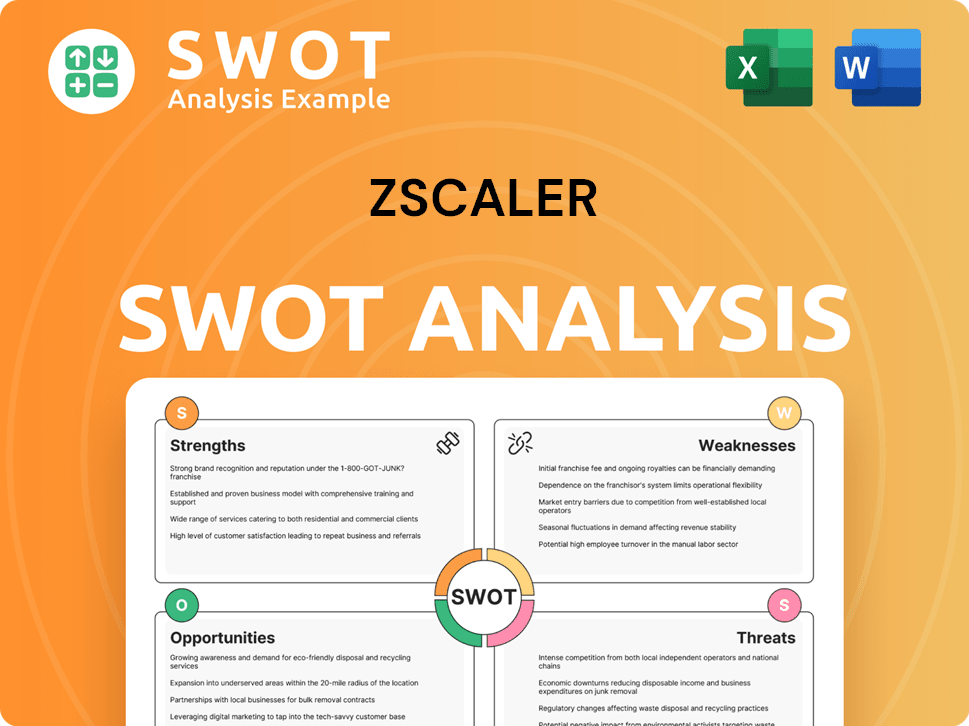
What Drove the Early Growth of Zscaler?
The early growth of the company, now known as a leading cybersecurity company, was marked by a strong focus on proving its cloud-native security platform's effectiveness and expanding its global presence. Following the launch of its Secure Web Gateway, the company quickly gained traction. Early clients included large enterprises dealing with the complexities of securing their distributed workforces and cloud applications. The initial team expansion prioritized engineering and sales, building the technical capabilities and market reach needed for its ambitious vision.
The company's early success was built on its Secure Web Gateway, which offered superior protection and simplified management compared to traditional solutions. This was followed by the introduction of additional cloud security services. These included cloud firewall, sandboxing, and data loss prevention, transforming the company into a comprehensive cloud security platform. These early products were key to its rapid expansion.
The company's growth was fueled by several rounds of venture capital funding. A $38 million Series A round in 2012 validated its market potential and enabled further investment in research and development and global expansion. The company established its first offices in San Jose, California, and later expanded internationally to support its growing customer base.
The early customer acquisition strategy emphasized the operational efficiencies and enhanced security posture offered by its cloud model. This attracted enterprises looking to modernize their security infrastructure. The market reception was increasingly positive as more organizations embraced cloud computing, and the company's platform proved to be a natural fit for securing these evolving environments. The company's approach to Marketing Strategy of Zscaler helped it gain traction.
The competitive landscape, initially dominated by legacy appliance vendors, began to shift. The company demonstrated the viability and advantages of a cloud-delivered security model. This set the stage for its eventual market leadership. The company's cloud-delivered security model offered significant advantages over traditional approaches.
Zscaler PESTLE Analysis
- Covers All 6 PESTLE Categories
- No Research Needed – Save Hours of Work
- Built by Experts, Trusted by Consultants
- Instant Download, Ready to Use
- 100% Editable, Fully Customizable
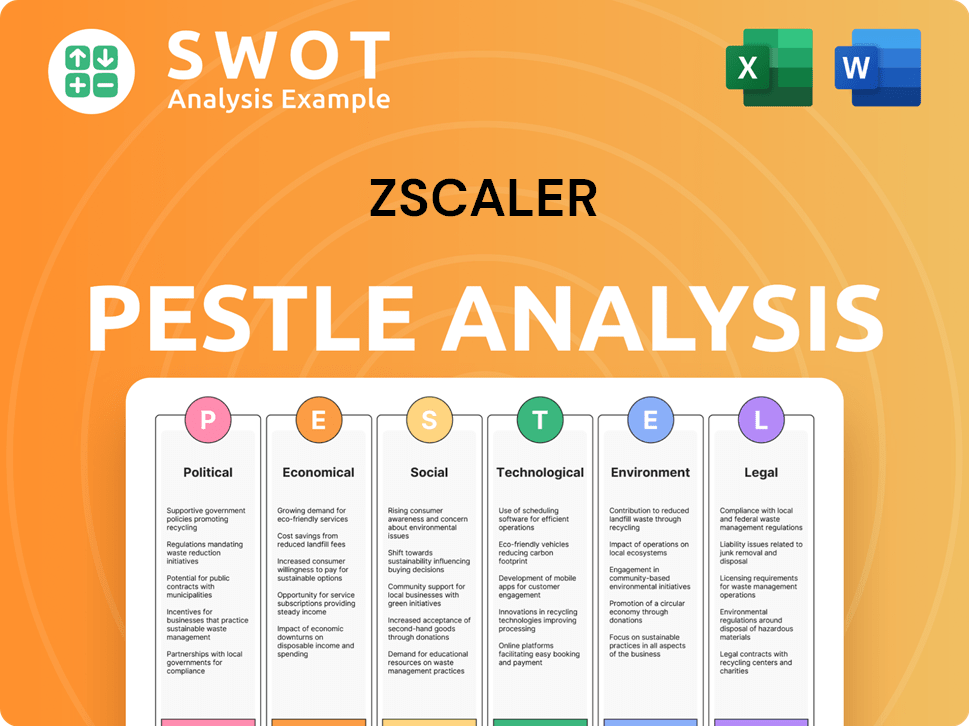
What are the key Milestones in Zscaler history?
The history of Zscaler is marked by pivotal milestones that have shaped its trajectory in the cybersecurity landscape. From its inception, the company has consistently pushed the boundaries of cloud security, establishing itself as a leader in the industry. The journey of the cybersecurity company, Zscaler, reflects its commitment to innovation and its ability to adapt to the ever-changing threat landscape.
| Year | Milestone |
|---|---|
| 2007 | Founded with a vision to provide internet security as a cloud service. |
| 2010s | Introduced its Zero Trust Exchange platform, a groundbreaking architecture that redefined secure access. |
| 2018 | Zscaler went public, marking a significant step in its growth and expansion. |
| 2021 | Acquired Trustdome to enhance its cloud security posture management capabilities. |
| Ongoing | Consistently recognized as a leader in Gartner's Magic Quadrant for Secure Web Gateways and Security Service Edge (SSE). |
Zscaler's innovations have been central to its success, particularly in the realm of cloud security. The company has secured numerous patents for its cloud security technologies, demonstrating its commitment to staying ahead of the curve. These advancements have solidified its position as a key player in the cybersecurity market.
Zscaler pioneered the Zero Trust Exchange, a platform that verifies every user and device before granting access to applications and data. This approach moves away from traditional perimeter-based security models. This architecture is designed to minimize the attack surface and prevent lateral movement within a network.
Zscaler delivers its security services from the cloud, providing scalability, ease of management, and consistent security policies across all locations and devices. This cloud-first approach allows for rapid deployment and updates. This also ensures that organizations can quickly adapt to new threats.
Zscaler integrates advanced threat protection capabilities, including sandboxing, intrusion detection, and data loss prevention, to protect against sophisticated cyberattacks. These features are continuously updated. They leverage threat intelligence from a vast network of users.
Zscaler's platform supports SASE, converging network and security functions into a single cloud-delivered service. This approach simplifies IT infrastructure. It improves security and enhances the user experience.
Zscaler offers robust DLP capabilities to prevent sensitive data from leaving the organization. This includes inspecting content in real-time and enforcing policies to protect against data breaches. This is especially important in today's environment.
Zscaler provides cloud browser isolation, which isolates web browsing activity to prevent malware from reaching the end-user device. This enhances security. It reduces the risk of infection from malicious websites.
Despite its achievements, Zscaler has faced challenges, including initial market skepticism and intense competition. Scaling its global cloud infrastructure to meet growing demand while maintaining performance has also been a focus. The company has overcome these hurdles through strategic innovation and adaptation.
Initially, there was skepticism about the effectiveness of cloud-delivered security. Zscaler had to demonstrate the benefits of its approach. The company focused on educating the market and showcasing its value proposition.
The cybersecurity market is highly competitive, with established vendors and new entrants vying for market share. Zscaler has differentiated itself through its innovative technology and focus on cloud security. The company continuously innovates to stay ahead.
Scaling its global cloud infrastructure to meet the demands of a growing customer base while maintaining performance and reliability posed a significant challenge. Zscaler has invested heavily in its infrastructure. This includes data centers and network capacity.
The cybersecurity threat landscape is constantly evolving, with new threats emerging regularly. Zscaler needs to adapt its solutions to address these threats. The company invests in research and development and threat intelligence.
Navigating the complexities of global data privacy regulations and compliance requirements is an ongoing challenge. Zscaler has to ensure its services meet the requirements of various regulations. The company has implemented robust compliance measures.
Integrating Zscaler's solutions with existing IT infrastructure and security tools can be complex. The company provides extensive integration capabilities. It also works with partners to ensure seamless deployment.
Zscaler's journey, from its inception to its current status as a leading cybersecurity company, is a testament to its innovation and resilience. For more insights into the company's financial aspects, you can read about the Owners & Shareholders of Zscaler.
Zscaler Business Model Canvas
- Complete 9-Block Business Model Canvas
- Effortlessly Communicate Your Business Strategy
- Investor-Ready BMC Format
- 100% Editable and Customizable
- Clear and Structured Layout
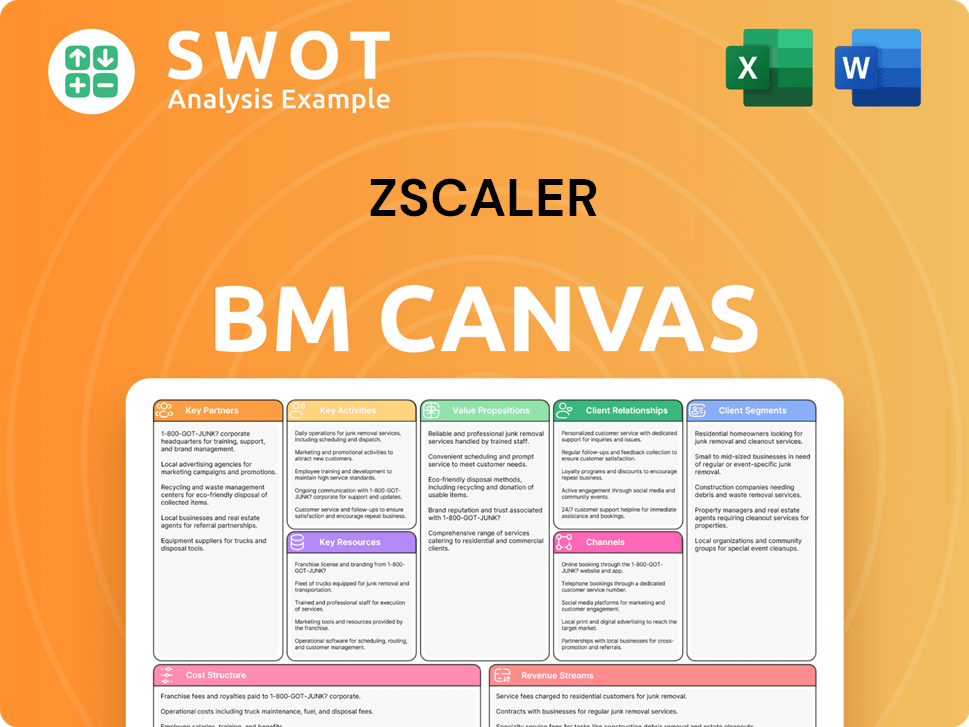
What is the Timeline of Key Events for Zscaler?
The Zscaler history is marked by significant milestones that have shaped its journey as a leading cybersecurity company. Founded in 2007 by Jay Chaudhry, the company quickly established itself in the cloud security market. Its evolution reflects a strategic adaptation to the changing cybersecurity landscape, from early product offerings to its current comprehensive security solutions.
| Year | Key Event |
|---|---|
| 2007 | Founded by Jay Chaudhry in San Jose, California. |
| 2008 | Launched its first cloud security service, the Secure Web Gateway. |
| 2012 | Secured $38 million in Series A funding, validating its market potential. |
| 2015 | Introduced the Zero Trust Exchange platform, a foundational shift in security architecture. |
| 2018 | Went public on NASDAQ under the ticker ZS, raising significant capital for expansion. |
| 2020 | Experienced accelerated growth due to the global shift to remote work, highlighting the relevance of its cloud security platform. |
| March 22, 2024 | Announced new AI-powered innovations to its Zero Trust Exchange, aiming to enhance threat detection and data protection. |
| 2024 | Continues to expand its global cloud footprint, reaching over 150 data centers worldwide. |
Zscaler is strategically positioned to benefit from the Secure Access Service Edge (SASE) model's ongoing convergence of networking and security. The company is expected to maintain its leadership in the SASE market. The SASE market is projected to reach $15.5 billion by 2028, presenting significant growth opportunities for Zscaler.
Zscaler is focused on AI-powered security innovations and expanding its platform capabilities to address emerging threats. The company aims to integrate advanced analytics and machine learning into its Zero Trust Exchange. This will enable more proactive and automated threat detection and response.
Zscaler continues to expand into new geographical markets. The company's global cloud footprint now includes over 150 data centers. Expansion into new markets is a key strategy for capturing a larger share of the growing cloud security market.
Jay Chaudhry's leadership emphasizes delivering a transformative security experience. The focus is on protecting users and data regardless of location. This vision reinforces the company's commitment to securing the cloud-first world.
Zscaler Porter's Five Forces Analysis
- Covers All 5 Competitive Forces in Detail
- Structured for Consultants, Students, and Founders
- 100% Editable in Microsoft Word & Excel
- Instant Digital Download – Use Immediately
- Compatible with Mac & PC – Fully Unlocked
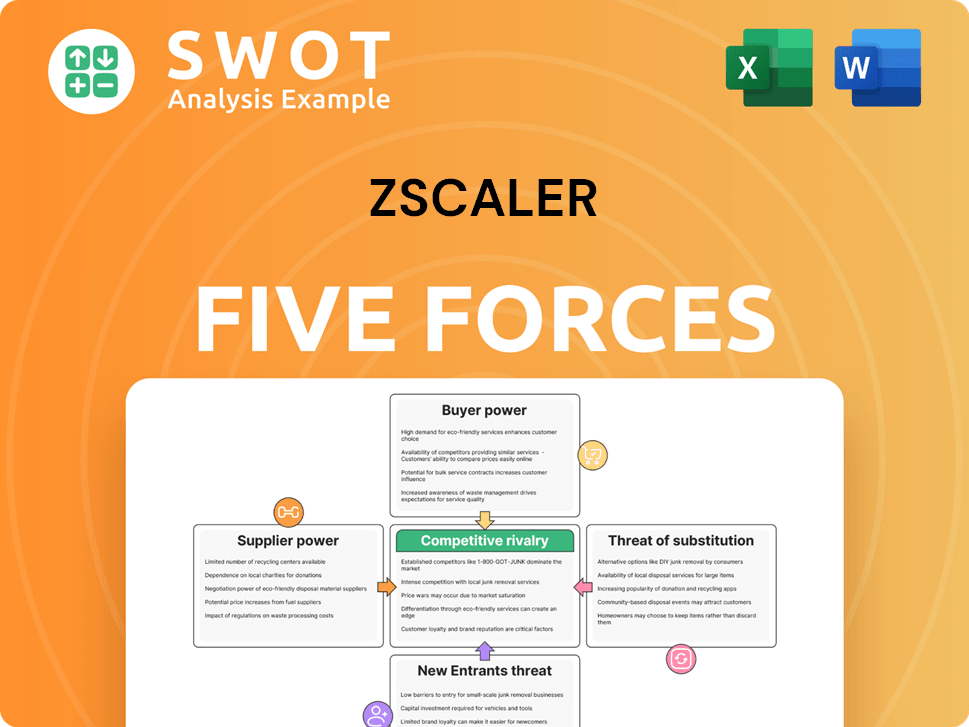
Related Blogs
- What is Competitive Landscape of Zscaler Company?
- What is Growth Strategy and Future Prospects of Zscaler Company?
- How Does Zscaler Company Work?
- What is Sales and Marketing Strategy of Zscaler Company?
- What is Brief History of Zscaler Company?
- Who Owns Zscaler Company?
- What is Customer Demographics and Target Market of Zscaler Company?
Disclaimer
All information, articles, and product details provided on this website are for general informational and educational purposes only. We do not claim any ownership over, nor do we intend to infringe upon, any trademarks, copyrights, logos, brand names, or other intellectual property mentioned or depicted on this site. Such intellectual property remains the property of its respective owners, and any references here are made solely for identification or informational purposes, without implying any affiliation, endorsement, or partnership.
We make no representations or warranties, express or implied, regarding the accuracy, completeness, or suitability of any content or products presented. Nothing on this website should be construed as legal, tax, investment, financial, medical, or other professional advice. In addition, no part of this site—including articles or product references—constitutes a solicitation, recommendation, endorsement, advertisement, or offer to buy or sell any securities, franchises, or other financial instruments, particularly in jurisdictions where such activity would be unlawful.
All content is of a general nature and may not address the specific circumstances of any individual or entity. It is not a substitute for professional advice or services. Any actions you take based on the information provided here are strictly at your own risk. You accept full responsibility for any decisions or outcomes arising from your use of this website and agree to release us from any liability in connection with your use of, or reliance upon, the content or products found herein.